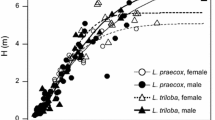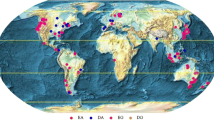Abstract
Acer platanoides L. individuals were dissected to determine if branch allometry changed as branches increased in length. Branches were found to transition from a log–log curvilinear relationship to a linear relationship when above 3,000 mm in length. The log–log linear relationship was best modeled with the elastic similarity model. The total number of subordinate lateral branches was found to increase rapidly after the primary branch length surpassed 3,000 mm, suggesting that branches are transitioning to a structural role as size increases. The shift in allometry appears to correspond to a shift from increasing slenderness ratio (length/radius) with increasing branch length to decreasing ratio, and is likely due to a transition from flexible sun branches to stiffer structural branches.







Similar content being viewed by others
References
Bertram JEA (1989) Size-dependent differential scaling in branches: the mechanics design of trees revisited. Trees 4:241–253
Dahle GA, Grabosky JC (2009) Review of literature on the function and allometric relationships of tree stems and branches. Arboric Urban For 35:311–320
Dean TJ, Long JN (1986) Validity of constant-stress and elastic-instability principles of stem formation in Pinus contorta and Trifolium pratense. Ann Bot 58:533–840
Eisner NJ, Gilman EF, Grabosky JC, Beeson RC Jr (2002) Branch junction characteristics affect hydraulic segmentation in red maple. J Arboric 28:245–251
Falster DS, Warton DI, Wright IJ (2006) SMATR: standardised major axis tests and routines, ver 2.0. Available at http://www.bio.mq.edu.au/ecology/SMATR/
Gradziel TM, Kester DE, Martinez-Gómez P (2002) A development based classification for branch architecture in almond. J Am Pomol Soc 56:106–112
Harris RW, Clark JR, Matheny NP (2004) Arboriculture, integrated management of landscape trees, shrubs, and vines. Prentice–Hall, Upper Saddle River, NJ, p 580
King DA (1986) Tree form, height growth, and susceptibility to wind damage in Acer saccharum. Ecology 67:980–990
King DA (1996) Allometry and life history of tropical trees. J Trop Ecol 12:25–44
Mäkelä A (2002) Derivation of stem taper from the pipe theory in a carbon balance framework. Tree Physiol 22:891–905
Manion PD (1981) Norway maple decline. J Arboric 7:38–42
Mardia KV (1972) Statistics of directional data. Academic Press, New York, p 357
McMahon TA (1973) Size and shape in biology: Elastic criteria impose limits on biological proportions, and consequently on metabolic rates. Science 179:1201–1204
McMahon TA (1975) Using body size to understand the structural design of animals: quadrupedal locomotion. J Appl Physiol 39:619–627
McMahon TA, Kronauer RE (1976) Tree structures: deducing the principle of mechanical design. J Theor Biol 59:443–466
Niklas KJ (1992) Plant biomechanics: an engineering approach to plant form and function. University of Chicago Press, Chicago, p 607
Niklas KJ (1994a) Allometry: the scaling of form and process. University of Chicago Press, Chicago, p 395
Niklas KJ (1994b) Interspecific allometries of critical buckling height and actual plant height. Am J Bot 81:1275–1279
Niklas KJ (1995) Size-dependent allometry of tree height, diameter and trunk-taper. Ann Bot 75:217–227
Niklas KJ (1997) Size- and age-dependent variation in the properties of sap- and heartwood in black locust (Robinia pseudoacacia L.). Ann Bot 79:473–478
Niklas KJ (2007) Maximum plant height and the biophysical factors that limit it. Tree Physiol 27:433–440
Niklas KJ, Spatz H-C (2000) Wind-induced stresses in cherry trees: evidence against the hypothesis of constant stress levels. Trees 14:230–237
Niklas KJ, Spatz H-C (2004) Growth and hydraulic (not mechanical) constraints govern the scaling of tree height and mass. Proc Natl Acad Sci 101:15661–15663
Nowak DJ, Rowntree RA (1990) History and range of Norway maple. J Arboric 16:291–296
O’Brien ST, Hubbell SP, Spiro P, Condit R, Foster RB (1995) Diameter, height, crown, and age relationships in eight neotropical tree species. Ecology 76:1926–1939
Osunkoya OO, Omar-Ali K, Amit N, Dayan J, Daud DS, Sheng TK (2007) Comparative height-crown allometry and mechanical design in 22 tree species of Kuala Belalong rainforest, Brunei, Borneo. Am J Bot 94:1951–1962
Rich PM, Helenurm K, Kearns D, Morse SR, Palmer MW, Short L (1986) Height and stem diameter relationships for dicotyledonous trees and arborescent palms of Costa Rican tropical wet forest. Bull Torrey Bot Club 113:241–246
Sæbø A, Borzan Ž, Ducatillion C, Hatzistathis A, Lagerström T, Supuka J, García-Valdecantos JL, Rego F, Van Slycken J (2002) The selection of plant materials for street trees, park trees and urban woodland. In: Konijnendijk CC, Nilsson K, Randrup TB, Schipperijn J (eds) Urban forests and trees. Springer, Berlin, p 520
Sposito TC, Santos FAM (2001) Scaling of stem and crown in eight Cecropia (Cecropiaceae) species of Brazil. Am J Bot 88:939–949
Sullivan LH (1896) The tall office building artistically considered. Lippincott’s Magazine. Cited from http://www.njit.edu/v2/Library/archlib/pub-domain/sullivan-1896-tall-bldg.html. Accessed 22 October 2007
Suzuki M, Hiura T (2000) Allometric differences between current-year shoots and large branches of deciduous broad-leaved tree species. Tree Physiol 20:203–209
Valentine FA, Westfall RD, Manion PD (1978) Street tree assessment by a survey sampling procedure. J Arboric 4:49–57
Warton DI, Wright IJ, Falster DS, Westoby M (2006) Bivariate line-fitting methods for allometry. Biol Rev 81:259–291
Acknowledgments
This effort was funded by John & Eleanor Kuser Faculty Scholar Endowment and the TreeFund. We would like to thank Drs. Peter Smouse, George Zimmerman and Ming Xu, and the anonymous reviewers for helpful comments on the manuscript and the assistance of our field technicians: Jessica Sanders, Manisha Patel, Alex O’Hare, and Paul Remelgado.
Author information
Authors and Affiliations
Corresponding author
Additional information
Communicated by T. Fourcaud.
Rights and permissions
About this article
Cite this article
Dahle, G.A., Grabosky, J.C. Allometric patterns in Acer platanoides (Aceraceae) branches. Trees 24, 321–326 (2010). https://doi.org/10.1007/s00468-009-0401-5
Received:
Revised:
Accepted:
Published:
Issue Date:
DOI: https://doi.org/10.1007/s00468-009-0401-5




